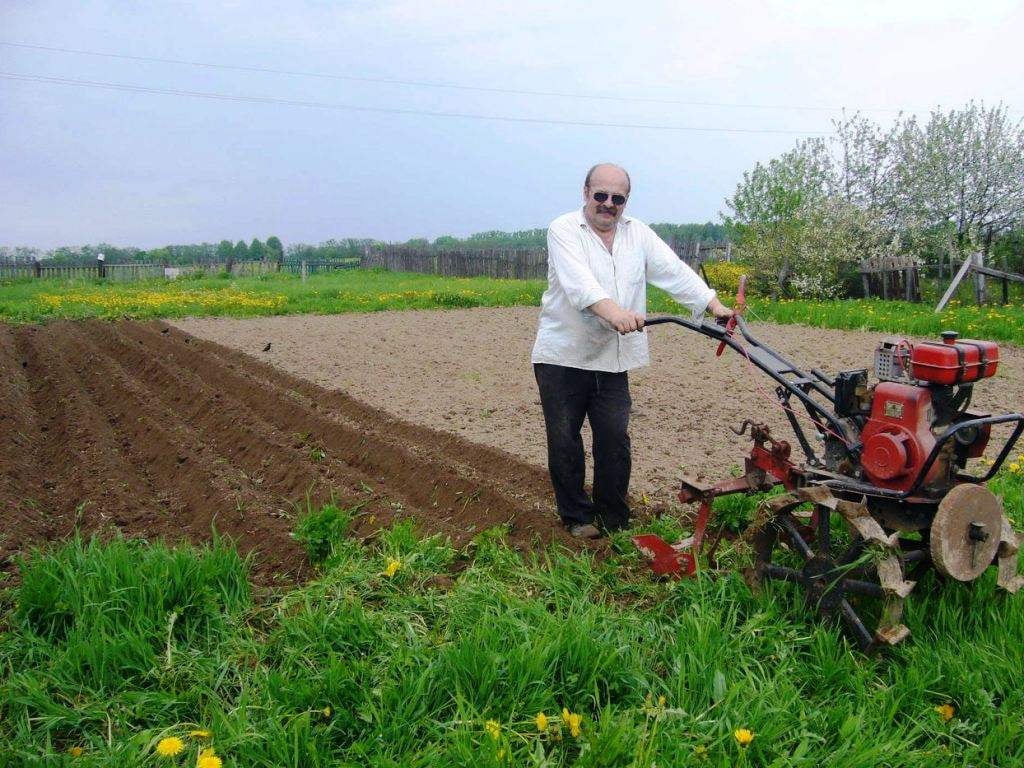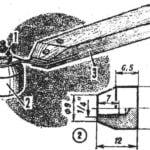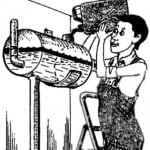 Well, the small tillers, in which the working body — a milling cutter biting into the ground with its rotating blades, it not only loosens the soil but also helps the tillers to move, as if pushing him forward.
Well, the small tillers, in which the working body — a milling cutter biting into the ground with its rotating blades, it not only loosens the soil but also helps the tillers to move, as if pushing him forward.
Another thing — the motor-plow: a ploughshare, pruning and the inversion layer of the earth, inevitably hinders, resists the movement of two-wheel tractor whose wheels begin to spin in one place. Attempts to combat this by hanging the additional weight is not so much help, how much more difficult work.
The original solution to this problem offered by the Hungarian craftsmen: is the weight of goods to replace the rubber wheel on the… concrete.
As shown in the diagram from the magazine “Earmaster”, the wheel consists of two main elements: a metal rim with cleats and concrete ring liner in it.
Let us consider these components.
Rim
For its production will need a metal strip and welding machine.
Actually the rim is a ring with a diameter of about 400 mm, welded from steel strip with a thickness of 3 to 4 mm and a width of 130 mm. On the outer surface of the ring welded to the plate lugs of the same steel strip; their height is about 40 mm.
The required radial stiffness of the rim is welded to attach to the side struts of the steel strips of the same thickness as the ring of the rim. They are arranged crosswise and have holes for attachment of the concrete liner and the intermediate disk under the axle of the cultivator.
Disk
As already mentioned, it is designed to fit wheel axle, which to him with one hand welded steel sleeve, turning the disk into a kind of hub.
A disk of sheet steel with a thickness of 5 mm; it drilled the holes for bolting it with the crosshairs of the rim.
Liner
It is cast of concrete separately, using any suitable shape (e.g. pelvis, metal or plastic). For secure attachment of the liner includes a metal insert, which is a section of pipe with welded thereto a plate on legs sleeves for the fasteners. The insert is embedded in the form when you fill it with concrete mixture.
The latter is prepared from cement and sand with the addition of gravel. The mixture is made in proportions 1:2:3, where one large part of the cement has two parts gravel and three parts sand.

“Concrete” wheel:
1 — rim (steel, strip 3×130); 2 — back (steel, strip 3×60); 3 — spacers (steel, strip 3×60); 4,9 — mount the hub (bolt with nut M8); 5,13 — mount concrete goals-weighting (bolt with nut M8); 6 — lugs (steel, strip 3×130); 7 — wheel hub (steel disk s5): 8 — tulka axis of the cultivator; 10 — washer-weighting (concrete); 11 glass washers-weighting (steel, sheet s5); 12 — guide mount washer-weighting: 14 — bracket guide washer-weighting
To obtain a quality solution, first mix the measured quantity of cement and sand, thoroughly mix them in any capacity or simply on a sheet of tin or plywood (where it makes a mound with a hole in the middle for water). Water is gradually added, again stirring thoroughly until it forms a thick solution, moderately plastic, but not flowing. Then add the gravel, mixing thoroughly again and, if necessary, adding water.
The finished mixture is put into the form and allowed to stand until the concrete is not lightly set (about three to seven days), sometimes dampening the surface to avoid cracking. With the same purpose form can be covered with a film.
Assembly
When all the elements of the wheels are ready, it remains to combine them together using bolts and nuts. While kept simple sequence: first the cross-hairs of the rim is attached to the disk hub, and then to their nests in the same crosshairs and the concrete liner.
With these wheels, the cultivator will not slip even on ploughed land.



